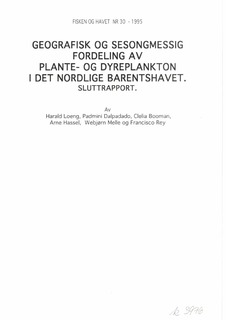| dc.description.abstract | The present report summarizes our knowledge on the distribution of phyto- and zooplankton in the
northern Barents Sea. More than 50% of the biomass of phytoplankton is produced during the
spring bloom period and takes place in the surface layer. During the summer, the bloom continues
with lower intensity just below the pycnocline, mainly at depths 20-50 m, depending on time and
place. The production is low during autumn and winter. Also the zooplankton is found at different
depths during the year. During the winter the zooplankton is more or less evenly distributed in the
water column. Zooplankton organisms reproduce during the phytoplankton bloom in spring. During
that period most of the zooplankton biomass is found in the surface layer. In the summer time,
the bulk of the biomass continue to concentrate at depths similar to phytoplankton maximum.
During autumn, the zooplankton will start to descent to greater depth. In the event of an oil spill the
ecosystem will be most vulnerable during the bloom period.NORSK SAMMENDRAG:Rapporten oppsummerer dagens kunnskaper om fordelingen av plante- og dyreplankton i tid
og rom i det nordlige Barentshavet. Mer enn halvparten av planteplanktonets biomasse blir
produsert under våroppblomstringen som finner sted i overflatelaget. Utover sommeren foregår
produksjonen av planteplankton, under sprangsjiktet, stort sett i dyp fra 20-50 m avhengig
av hvor man er og når man observerer. Utover høsten og vinteren en produksjonen lav.
Dyrplanktonet finnes også ulike steder i vannsøylen. Om vinteren er det noenlunde jevnt
fordelt i vannsøylen med en tendens ti1 høyere verdier med dypet. Det meste av dyreplanktonet
reproduserer i tilknytning ti1 planteplanktonets våroppblomstring, og i denne tiden er både
voksne og egg å finne i overflatelaget. Utover sommer vil hovedtyngden av dyreplanktonet
være å finne nær det dypet hvor planteplanktonet befinner seg. I løpet av høsten vil dyreplanktonet
vandre mot dypere vannlag. Med tanke på et oljespill vil okosystemet være mest
såbart i tiden under og like etter maksimum blomstring av planteplankton. | en |
